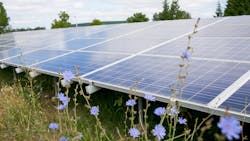As cities across the country face increasingly extreme weather events and economic challenges, they’ve turned to their wastewater treatment plants as untapped sources of renewable energy. And with technologies like cogeneration engines (which use biogas to produce renewable electricity on-site) becoming more accessible in the U.S. and funding opportunities on the rise, the time to act is now.
In Oregon, municipal leaders are taking advantage of new opportunities like cogeneration engines to help achieve the state’s climate action goals of reducing greenhouse gas emissions at least 45 percent below 1990 emissions levels by 2035 and at least 80 percent below 1990 levels by 2050.
At many wastewater treatment facilities, methane is typically wasted by burning or flaring, which releases greenhouse gas emissions like carbon dioxide and methane into the atmosphere. Cogeneration engines, instead, convert methane into renewable energy, thus reducing emissions.
To date, 10 Oregon wastewater facilities use biogas to power their facilities, with the potential for more to do the same.
“There is something every community — big or small — can do to play their part in fighting climate change,” said Joshua Reed, project manager at Energy Trust of Oregon. “At a basic level, communities can start by identifying ways for their wastewater treatment facilities to use less energy and by taking steps like installing solar power. In facilities with anaerobic digesters, which break down organic waste and produce methane gas, leaders can go further by adding a cogeneration engine that can use biogas as fuel to produce electricity and heat, which can reduce the amount of power they must buy.”
Barriers to Efficiency
While any community can make energy efficiency and renewable energy upgrades to their wastewater plants, there are often financial and technical hurdles to overcome. And like much of the infrastructure in the U.S., many wastewater treatment facilities have a long list of deferred maintenance to take care of. Budgets are tight, and since the priority is to keep plants running well and cleaning water, energy efficiency can fall to the bottom of the to-do list.
One non-profit, Energy Trust of Oregon helps facilities overcome these barriers by proving technical support and financial incentives for preliminary studies, design work ,and project implementation costs.
“These energy upgrades at wastewater treatment plants build our communities’ resiliency, helping the critical infrastructure we rely on better withstand the effects of climate change,” said Reed.
In the Portland metro tri-county region, which accounts for about half of the state’s 4.27 million residents, Energy Trust has supported four plants in making energy upgrades: Clackamas County’s Tri-City Water Resource Recovery Facility, City of Gresham’s Wastewater Treatment Plant, Clean Water Services’ Durham Treatment Facility, and Portland’s Columbia Boulevard Wastewater Treatment Plant.
Clackamas County
Most recently, Energy Trust partnered with Clackamas Water Environment Services (WES) in Clackamas County, which cleans over 11 million gallons of wastewater every day for over 190,000 county residents at their Tri-City Water Resource Recovery Facility.
The facility already converted waste materials into renewable biogas but, after more than 30 years of service and a significant increase in the number of people served by the facility, it was time for an upgrade. The two existing anaerobic digester tanks that handle biosolids had reached capacity and were no longer operating efficiently, so a new one was added. The original cogeneration engine had also reached the end of its life.
As part of the upgrades completed in July 2021, a new 600-kW, lean-burn engine was connected to the digester tanks. Excess heat produced by burning the methane in the engine is now captured and used to heat the digesters and for space heating.
In total, the system will produce an estimated 4,300 megawatts of electricity a year — enough to offset nearly half of the facility’s energy use — as well as provide heat for five buildings at the site.
“We estimate saving about $319,000 on power and $99,500 on heat in the first year. As our population grows and waste loads to the plant increase, the average annual savings are anticipated to be about $619,000 on power and $191,000 on heat over the life of the engine,” said Lynne Chicoine, capital program manager at WES.
City of Gresham
The Clackamas project follows on the heels of similar biopower upgrades at the City of Gresham’s wastewater treatment plant: the first in the Pacific Northwest to generate the same amount of electricity as it consumes in a year.
Gresham’s wastewater treatment facility achieved its net-zero energy-consumption goal through the use of two, 395-kilowatt cogeneration engines fueled by biogas produced from the anaerobic digestion of wastewater solids, a 420-kilowatt ground mount solar electric system, and increased production of biogas from the co-digestion of fats, oils and grease from area restaurants and food processors. Between 2008 and 2015, the Gresham facility reduced its total electrical load by 8 percent, a reduction in emissions equivalent to taking more than 800,000 cars off the road.
Clean Water Services
Similarly, Clean Water Services’ Durham Treatment Facility is also using multiple inputs to generate renewable energy, using a cogeneration system built in 2016. In addition to municipal wastewater solids, the facility’s 1.7-megawatt cogeneration system is fueled by biogas from the anaerobic digestion of fats, oils and grease from restaurants and other businesses.
By adding these inputs, the facility is converting unwanted waste to clean energy. Generating 60 percent of the electricity needed to run the facility, Clean Water Services avoids the production of 6,000 tons of carbon dioxide and reduces operating costs by nearly $800,000 annually.
Portland’s Columbia Boulevard Plant
At Portland’s Columbia Boulevard Wastewater Treatment Plant, which installed two cogeneration engines in 2009, leaders are continuing to advance their use of renewable energy. To capture almost 100 percent of the methane generated from wastewater treatment, the plant is now working to convert methane into renewable natural gas to displace diesel fuel for its medium and heavy-duty vehicles.
In each of these communities, Energy Trust supported the cost of energy feasibility studies, offered technical support and provided financial incentives for the purchase of equipment once plans were finalized.
“Leaders at plants across Oregon are realizing the energy-generating potential of these facilities and are paving the way toward a clean energy future,” said Reed. “We are committed to helping these communities achieve their climate action goals by creating a future where water treatment facilities are viewed as clean energy power plants.”
While there are no requirements for wastewater treatment facilities to make upgrades, more leaders are realizing the potential of these facilities to support long-term financial and environmental goals. With funding opportunities being explored at state and national levels, municipalities are well-positioned to make energy-efficiency upgrades that will meet climate-action goals and extend the benefit of renewable power to more residents. WW
About the Author: David Moldal is a senior program manager at the Energy Trust of Oregon, where he develops and manages custom renewable energy projects for the benefit of Portland General Electric and Pacific Power customers.
Published in WaterWorld magazine, December 2021.
About the Author

David Moldal
David Moldal is a senior program manager at the Energy Trust of Oregon, where he develops and manages custom renewable energy projects for the benefit of Portland General Electric and Pacific Power customers.
